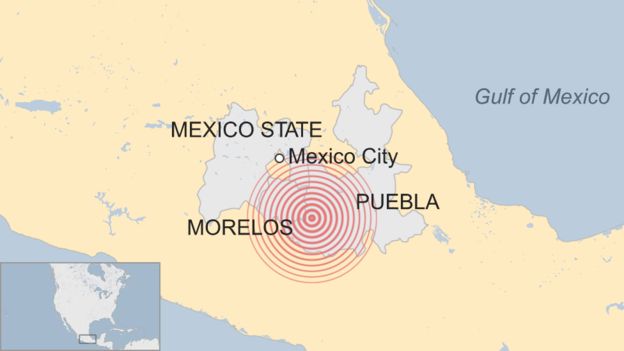The magnitude 7.1 earthquake that hit Mexico on the 19th September 2017, with the epicentre near Atencingo in Puebla state but the damage being considerable in Mexico City 75 miles away, is estimated to have caused as much as US $4.8 billion of losses to insurance and reinsurance interests.
 Risk modellers estimates diverge considerably though, with AIR Worldwide putting the industry loss at up to $2.1 billion, RMS saying the re/insurance industry loss would not exceed $1.2 billion, but the Mexico City headquartered seismic engineering specialists ERN International estimated the insured loss at up to $4.8 billion.
Risk modellers estimates diverge considerably though, with AIR Worldwide putting the industry loss at up to $2.1 billion, RMS saying the re/insurance industry loss would not exceed $1.2 billion, but the Mexico City headquartered seismic engineering specialists ERN International estimated the insured loss at up to $4.8 billion.
ERN told us that its estimate of insured losses from the M7.1 Puebla region and Mexico City earthquake is based on modelling of a portfolio of buildings representative of the size and distribution of insured buildings in the region. AIR’s and RMS’ loss estimates are based on their respective risk modelling platforms and exposure data as well.
The divergence in estimates highlights how difficult it can be making accurate assessments of the potential volume and amount of claims that insurance and reinsurance interests will be liable for so soon after an earthquake event. Earthquakes can be long-tailed, in terms of the development of claims and so the final costs to the industry will take some time to become clear.
AIR Worldwide said it puts the industry loss in a range from around $735 million to $2.1 billion, quite a large range in itself.
AIR explained the quake and the estimate:
This M7.1 earthquake occurred in central Mexico, roughly 55 km south-southwest of the city of Puebla and 120 km southeast of Mexico City, where major damage and hundreds of fatalities have been reported. The President of Mexico declared a state of emergency for areas impacted by the M7.1 quake. In Mexico City, 52 buildings collapsed, including a 10-unit apartment building, a four-story school, and a three-story textile factory; about 500 more buildings were damaged throughout the capital, including 22 hospitals, several churches, a sports arena, and a medical laboratory.
According to the Federal Electricity Commission, power was restored on the night of September 21 to 4.63 million households and business, representing 95% of those that had lost power after the quake, mostly in Mexico City and in the states of Guerrero, Morelos, Puebla, Oaxaca, and Tlaxcala. Telephone lines were downed, and gas mains were ruptured. Schools in the region have been closed until further notice.
According to AIR, the majority of residential buildings in Mexico are of masonry construction, falling into one of three classifications: reinforced masonry, confined masonry, and unreinforced masonry. Unreinforced masonry is the construction type most vulnerable to shake damage. Commercial buildings in Mexico are primarily of engineered masonry or concrete construction, and are better able to withstand ground motion. In Mexico City, most middle- to upper-class families live in five- to 15-story reinforced concrete commercial dwellings. These buildings are generally well designed and built with high quality materials. However, reinforced masonry and confined masonry buildings still account for a large portion of the building stock of Mexico City.
AIR’s loss estimates explicitly capture damage from ground shaking. Note that AIR’s estimates of insured losses are based on assumptions about take-up rates in Mexico (the percentage of properties actually insured against the earthquake peril), about which there is considerable uncertainty. Please note that total economic losses are expected to be much higher than industry insured loss estimates. The range in AIR’s loss estimates reflects uncertainty in earthquake source parameters, modeled ground motion, and damage estimation.
RMS said that its estimate is that the insured loss would not exceed $1.2 billion and explained its preliminary loss estimate:
Economic shake losses will be between US$4 billion and $8 billion. This is based on current building damage information from the Mexican authorities. RMS has also analyzed data on ground motion, and examined how property exposures are distributed across the region.
Because of low insurance penetration rates across Mexico, particularly in residential lines, RMS expects that insured losses will not exceed $1.2 billion. This estimate accounts for shake-only insured losses to structures, contents and business interruption including the effects of liquefaction and landsliding. Post-event loss amplification is not expected to be a significant factor in these losses.
There is likely to be a reasonable share of this loss for major reinsurance firms and syndicates at Lloyd’s, as well possibly as some collateralized reinsurance or retro players as well.
As we wrote at the time of this quake, it will not be able to trigger the IBRD / FONDEN 2017 catastrophe bond as that is already set to payout for the earlier M8.1 quake in the Chiapas region of Mexico.
 View all of our Artemis Live video interviews and subscribe to our podcast.
View all of our Artemis Live video interviews and subscribe to our podcast.
All of our Artemis Live insurance-linked securities (ILS), catastrophe bonds and reinsurance video content and video interviews can be accessed online.
Our Artemis Live podcast can be subscribed to using the typical podcast services providers, including Apple, Google, Spotify and more.































